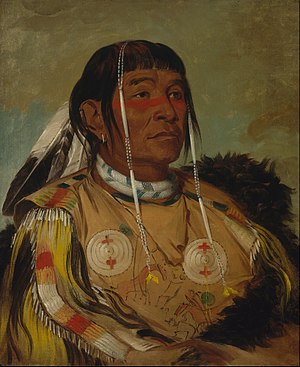Sha-có-pay is an oil-on-canvas painting from life by American artist George Catlin. It depicts an indigenous American named Sha-có-pay (which means "The Six" in the Dakota language), who was chief of the Plains Ojibwe. Catlin traveled throughout Western North America, painting indigenous peoples at a time when the only contact with Europeans was from explorers and traders. The painting shows traditional Plains Ojibwe clothing such as a beaded buckskin shirt, a buffalo-hide robe, eagle feathers, hair pipes, and a beaded necklace that is found only among the tribes of the northernmost plains, the Ojibwe and the Cree. The portrait was painted by the artist during a trip to Fort Union in 1832. It now resides in the Smithsonian American Art Museum in Washington, D.C.Painting: George Catlin
